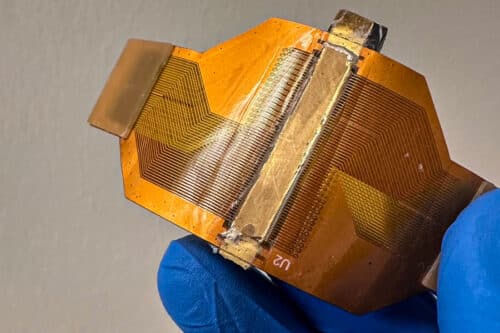This wearable ultrasound sticker can detect changes in the stiffness of deep internal organs, potentially identifying early signs of acute liver failure.

In a stride toward enhancing healthcare, MIT engineers have unveiled an ultrasound sticker, no larger than a postage stamp, capable of monitoring the stiffness of internal organs. This innovative technology aims to detect signs of disease, such as liver and kidney failure and tumour progression, offering a new horizon in medical diagnostics. The research introduces a sensor that sends and receives sound waves through the skin to reflect off organs, providing a “signature” of organ rigidity. “This wearable sticker allows for the continuous monitoring of organ stiffness, a critical factor in early disease diagnosis,” explains Xuanhe Zhao, a leading figure behind the study.
The sticker has proven its efficacy over 48-hour periods, detecting subtle changes indicative of disease progression. Initial tests on rats have shown its potential in identifying early signs of acute liver failure, setting the stage for human application. The researchers aim to use these sensors in ICUs for post-transplant monitoring, highlighting its significance in early intervention.
Sensing Beyond the Surface
Unlike traditional methods that require the manual operation of ultrasound probes, this sticker offers a continuous, non-invasive alternative. By capturing shear waves, the sticker can measure organ rigidity, providing vital data without the need for constant manual intervention. By miniaturizing the technology to fit on a tiny chip, the team has maintained the sensitivity of conventional ultrasound probes. This advancement could revolutionize how patients’ organ health is monitored, especially after transplants, by providing uninterrupted data on organ stiffness.
The team is working towards making the sticker usable in clinical settings, particularly for monitoring patients post-transplant in ICUs. There’s also potential for a more portable version for at-home patient use, allowing for long-term monitoring of conditions like solid tumour progression.
This development not only promises to enhance patient care by enabling early detection and intervention but also aims to alleviate the workload on healthcare professionals by offering a reliable, low-maintenance monitoring solution. As Zhao envisions, this technology could someday become a staple in personal health monitoring, transforming the landscape of medical diagnostics and patient care. Supported by the National Institutes of Health, this work paves the way for a future where monitoring organ health is as simple as applying a sticker.







